How to choose fiberglass pipes: production specifics and an overview of leading manufacturers
Thanks to the combination of the positive characteristics of glass and polymers, fiberglass pipes have almost unlimited application prospects - from arranging ventilation ducts to laying petrochemical routes.
In this article, we consider the main characteristics of fiberglass pipes, marking, polymer composite manufacturing techniques and the composition of the binder components that determine the scope of the composite.
We also give important selection criteria, paying attention to the best manufacturers, because an important role in the quality of products is assigned to the technical capacities and reputation of the manufacturer.
The content of the article:
General characteristics of fiberglass
Fiberglass - a plastic material, which includes fiberglass components and a binder filler (thermoplastic and thermosetting polymers). Along with a relatively low density, fiberglass products are characterized by good strength properties.
The last 30-40 years fiberglass is widely used for the manufacture of pipelines for various purposes.
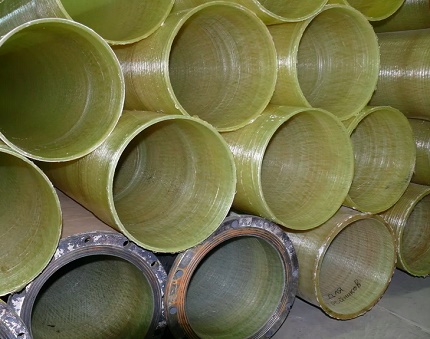
Highways combine the qualities of glass and polymers:
- Light weight. The average fiberglass weight is 1.1 g / cc. For comparison, the same parameter for steel and copper is much higher - 7.8 and 8.9, respectively.Thanks to ease, installation works and transportation of material are facilitated.
- Corrosion Resistance The components of the composite have a low reactivity, therefore, they are not subjected to electrochemical corrosion and bacterial decomposition. This quality is a decisive argument in favor of fiberglass for underground utilities.
- High mechanical properties. The absolute tensile strength of a composite is inferior to that of steel, but the specific strength parameter significantly exceeds thermoplastic polymers (PVC, HDPE).
- Weather resistant. The range of boundary temperatures (-60 ° C .. + 80 ° C), the treatment of pipes with a protective layer of gelcoat provides immunity to UV rays. In addition, the material is resistant to wind (the limit is 300 km / h). Some manufacturers claim earthquake resistance of pipe fittings.
- Fire resistance. Non-combustible glass is the main component of fiberglass, so the material is hardly flammable. When burning, toxic gas dioxin is not released.
Fiberglass has a low thermal conductivity, which explains its heat-insulating qualities.
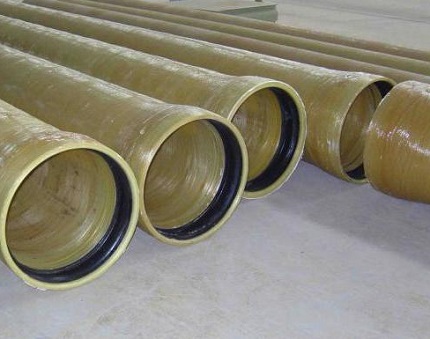
As the inner walls wear out, the fibers become exposed and break off - particles can enter the transported medium.
Fiberglass Pipe Manufacturing Technologies
Physico-mechanical characteristics of the finished product depend on the production technique. Composite fittings are manufactured in four different ways: extrusion, pultrusion, centrifugal casting and winding.
Technology # 1 - Extrusion
Extrusion is a technological process based on the continuous forcing of a paste-like or highly viscous material through a forming tool. The resin is mixed with crushed fiberglass and a plastic hardener, and then fed into the extruder.
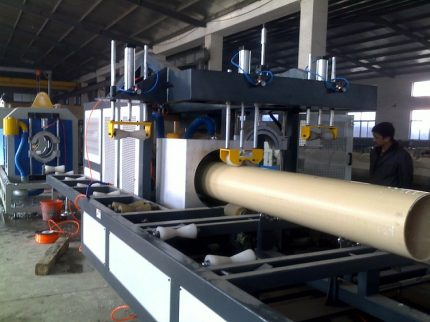
High-performance extrusion line allows you to get frameless composite products at a low price, but the demand for it is limited due to the low mechanical properties. The basis of the polymer matrix is polypropylene and polyethylene.
Technology # 2 - Pultrusion
Pultrusion is a technology for manufacturing composite long elements of small diameter with a constant cross section. Passing through a heated mold-forming die (+140 ° С), the details are “pulled” out of fiberglass material impregnated with thermosetting resin.
Unlike the extrusion process, where pressure is the determining influence, in the pultrusive unit this role is played by the pulling effect.
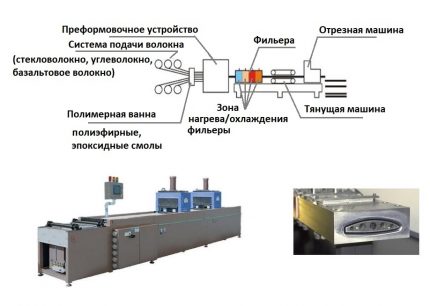
Technological process:
- Fibrous filaments from coils are fed into a polymer bath, where they are impregnated with thermoplastic resins.
- The processed fibers pass through a preforming unit - the threads are aligned and acquire the desired shape.
- Uncured polymer enters the die. Due to several heaters, an optimal mode for polymerization is created and the pulling speed is selected.
The cured product is pulled by a pulling machine and cut into segments.
Distinctive features of pultruded technology:
- acceptable polymers - epoxy, polyester resins, vinyls;
- pulling speed - the use of innovative optimized "pultruded" polymers allows you to accelerate broaching up to 4-6 m / min. (standard - 2-3 m / min.);
- run-up run: minimum - 3.05 * 1 m (pulling force up to 5.5 t), maximum - 1.27 * 3.05 m (force - 18 t).
The output is a pipe with perfectly smooth external and internal walls, at a high level and strength indicators.
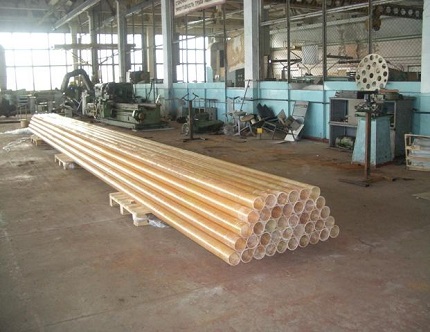
The disadvantages of the method do not relate to the quality of the original product, but to the technology itself. Arguments “against”: the high cost and duration of the production process, the inability to manufacture large diameter pipes designed for significant loads.
Technology # 3 - Centrifugal Casting
Swiss company Hobas developed and patented centrifugal forming technique. In this case, the production is carried out from the outer wall of the pipe to the inner one by using a rotating form. The composition of the pipeline includes: crushed glass tows, sand and polyester resins.
Raw materials are fed into a rotating matrix - the structure of the outer surface of the pipeline is formed. As production proceeds, solid components, filler and fiberglass are mixed with the liquid resin - polymerization proceeds faster under the influence of the catalyst.
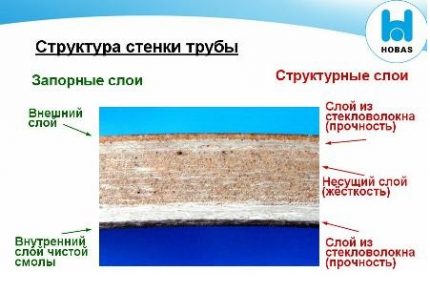
Additional advantages:
- high accuracy of the dimensions of the initial product (the internal section of the rotating form corresponds to the external diameter of the finished product)
- the ability to cast a wall of any thickness;
- high ring stiffness of the polymer composite;
- obtaining a smooth surface outside and inside the pipe fittings.
The disadvantage of centrifugal production of fiberglass pipes is the energy intensity and high cost of the final product.
Technology # 4 - progressive winding
The most popular technique is continuous winding.The pipe is created by alternating the mandrel with fiberglass with polymers with cooling processes. The production method has several subspecies.
Spiral ring technology
The fiber stacker is a special ring, on the circumference of which there are spinnerets with threads.
The working element continuously moves along the axis of the moving frame and distributes the fibers along the helical lines.
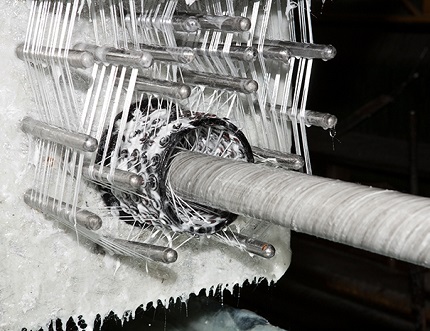
The main advantages of the method:
- uniform strength over the entire surface of the highway;
- excellent tolerance of tensile loads - cracks are excluded;
- creation of products of variable diameter and cross sections with a complex configuration.
This technique makes it possible to obtain high-strength pipes designed for operation under high pressure (pump-compressor engineering networks).
Spiral tape winding
The technique is similar to the previous one, the difference is that the stacker feeds a narrow ribbon of fibers. A dense reinforcing layer is achieved by increasing the number of passes.
Cheaper equipment is involved in the production than with the spiral-ring method, but a couple of significant disadvantages are inherent in the “ribbon” winding:
- limited performance;
- loose laying of fibers reduces the strength of the pipeline.
The spiral-tape method is relevant in the manufacture of pipe fittings for low, moderate pressure.
Longitudinal-transverse method
Continuous winding is carried out - the stacker places the longitudinal and transverse fibers at the same time. There is no reverse movement.
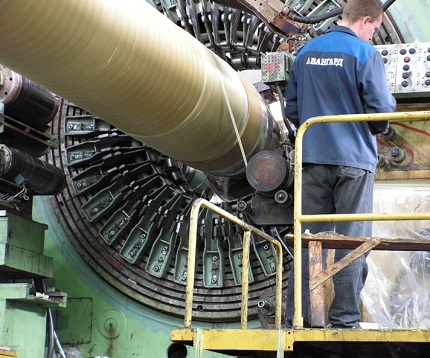
Method characteristics:
- It is used mainly when creating pipes with a cross section up to 75 mm;
- there is the possibility of tensioning the axial threads, due to which strength is achieved, as in the spiral method.
Longitudinal transverse technology is highly productive. Machines allow you to change the ratio of axial and annular reinforcement in a wide range.
Slanting transverse longitudinal technology
The development of Kharkov engineers is in demand among domestic manufacturers. When cross-wound winding, the stacker displays a “veil” consisting of a bundle of binder threads. The tape is fed to the frame at a slight overlap angle with the previous turn - ring reinforcement is formed.
Upon completion of the processing of the entire mandrel, the fibers are rolled in by rollers - the remains of the binder polymers are removed, the reinforcing coating is compacted.

Features of cross-layer rolling:
- fiberglass tightness;
- unlimited diameter of produced pipes;
- high dielectric properties due to the absence of continuous reinforcement along the axis.
The elastic modulus of the “cross-layer” fiberglass is inferior to the similar parameter of other techniques. Due to the risk of interlayer cracks, the method is not feasible when creating pipelines under high pressure.
Fiberglass Pipe Selection Parameters
The choice of glass composite pipes is based on the following criteria: stiffness and design pressure, type of binder component, structural features of the walls and method of connection. Significant parameters are indicated in the accompanying documents and on each tube - abbreviated marking.
Rigidity and pressure rating
Fiberglass stiffness determines the ability of the material to withstand external loads (soil severity, traffic) and pressure on the walls from the inside.According to ISO standardization, pipe fittings are classified into several classes of stiffness (SN).

The degree of rigidity increases with increasing wall thickness of the fiberglass pipe.
Classification by nominal pressure (PN) reflects the gradation of products with respect to safe fluid pressure at a temperature of +20 ° C over the entire service life (about 50 years). The unit of measurement for PN is MPa.
Some manufacturers, such as Hobas, indicate combined characteristics for two parameters (pressure and stiffness) through a fraction. Pipes with a working pressure of 0.4 MPa (class PN - 4) with a degree of rigidity (SN) of 2500 Pa will be marked - 4/2500.
Type of Binder
The operational properties of the pipe largely depend on the type of binder. In most cases, polyester or epoxy additives are used.
Features of PEF Binders
The walls are formed from thermosetting polyester resins reinforced with fiberglass and sand additives.
The polymers used have important qualities:
- low toxicity;
- curing in room temperature conditions;
- reliable coupling with glass fibers;
- chemical inertness.
Composite pipes with PEF polymers are not subject to corrosion and aggressive media.

Epoxy Characteristics
A binder gives the material increased strength. The temperature limit of composites with epoxides is up to +130 ° С, and the maximum pressure is 240 atmospheres.
An additional advantage is almost zero thermal conductivity, so the assembled trunk does not require additional thermal insulation.
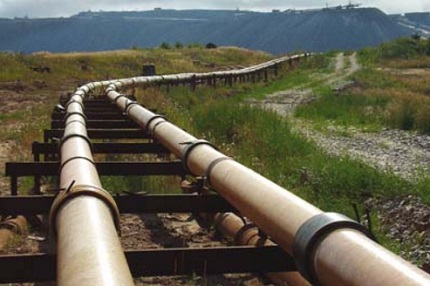
Wall design of composite pipes
According to the design, they distinguish: one-, two- and three-layer fiberglass pipes.
Characteristics of single-layer products
The pipes do not have a protective lined coating, due to which they are of low cost. Features of pipe fittings: inability to use in regions with difficult terrain and harsh climate.
Also, these products require careful installation - digging a large volume of trench, arranging a sandy "pillow". But the estimate of installation work is increasing because of this.
Features of double-layer pipes
Products inside are lined with a film coating - high pressure polyethylene. Protection increases chemical resistance and improves the tightness of the line under external loads.
However, the operation of fittings in oil pipelines revealed the weaknesses of two-layer modifications:
- lack of adhesion between the structural layer and the lining - violation of the solidity of the walls;
- deterioration of the elasticity of the protective film at subzero temperatures.
When transporting a gas-containing medium, the lining may delaminate.

Three-layer pipe parameters
Fiberglass Pipe Structure:
- External polymer layer (1-3 mm thick) - increase in mechanical and chemical resistance.
- Structural layer - structural layer responsible for the strength of the product.
- Liner (thickness 3-6 mm) - fiberglass inner shell.
The inner layer provides smoothness, tightness and smooths out cyclic fluctuations in internal pressure.
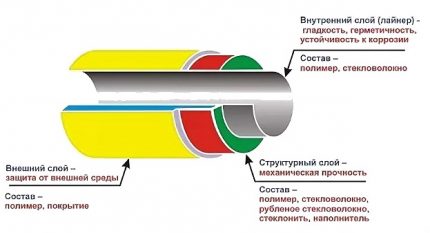
Fiberglass Docking Method
According to the method of connection, the assortment of pipe fittings made of composite is divided into 4 groups.
Group No. 1 - socket-spiked docking
Elastic rubber gaskets are mounted in mating grooves on the pipe end spikes. Landing rings are formed on equipment with electronic control, ensuring the accuracy of their location and size.

Group No. 2 - socket-thorn with seal and stopper
When arranging a land highway, it is necessary to compensate for the effect of axial forces on the pipeline. For this purpose, in addition to the seal, a stop is placed. The element is made of a metal cable, polyvinyl chloride or polyamide.
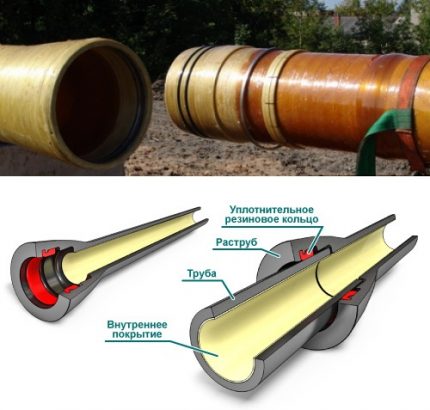
Group No. 3 - flange connection
Docking of a composite pipeline with fittings or metal pipes. The connecting dimensions of fiberglass flanges are regulated GOST 12815-80.
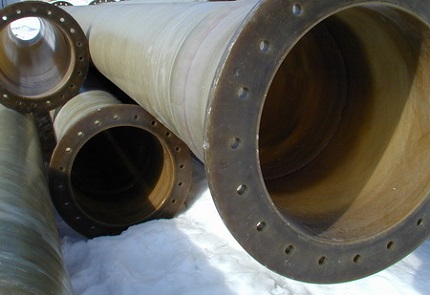
Group No. 4 - adhesive fixation
Inseparable method of connection - the composition of reinforcing glass materials with the addition of a polyester component of “cold” curing is applied to the tips. The method provides strength and tightness of the line.
Marking the protective inner layer
The methodology for the production of pipe products allows you to produce products with different composition of the inner layer, which determines the resistance of the line to the transported medium.
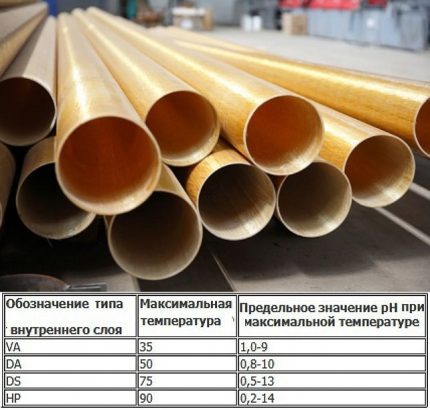
Domestic manufacturers apply the following marking of protective coatings.
The letter indicates the acceptable use:
- AND - transportation of liquid with abrasives;
- P - supply and discharge of cold water, including drinking;
- X - permissible use in chemically aggressive gas and liquid environments;
- G - hot water supply systems (limit 75 ° C);
- WITH - other liquids, including those with high acidity.
The protective coating is applied with a layer of up to 3 mm.
Overview of products from leading manufacturers
Among the variety of products presented there are reputable brands with many years of positive reputation. These include products of companies: Hobas (Switzerland), Steklokompozit (Russia), Amiantit (a concern from Saudi Arabia with production facilities in Germany, Spain, Poland), Ameron International (USA).
Young and promising manufacturers of composite fiberglass pipes: Polyek (Russia), Arpipe (Russia) and Fiberglass Plant (Russia).
Manufacturer # 1 - HOBAS Brand
Brand name factories are located in the USA and many European countries. Hobas products have earned worldwide recognition for their excellent quality. GRT pipes with a polyester binder are made using the centrifugal casting technique of fiberglass and unsaturated polyester resins.
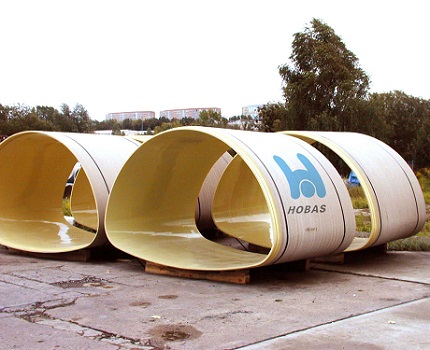
Characteristics of Hobas composite pipes:
- diameter - 150-2900 mm;
- SN stiffness class - 630-10 000;
- PN-pressure level - 1-25 (PN1 - pressureless pipeline);
- the presence of an internal lining anti-corrosion coating;
- acid resistance over a wide pH range.
The production of shaped parts: elbows, adapters, flanged pipes and tees has been established.
Manufacturer # 2 - Steklokompozit company
The company "Steklokompozit" established a line for the production of fiberglass pipes Flowtech, production technology - continuous winding.
Involved equipment with a double supply of resinous substances. High-tech resins are used for laying the inner layer, and a cheaper composition is applied to the structural layer. The technique allows to rationalize the consumption of material and reduce the cost of production.
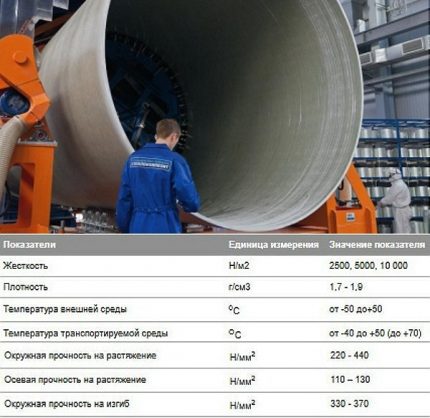
Manufacturer # 3 - Amiantit Brand
The main components of Amiantit's Flowtite pipes are fiberglass, polyester resin, sand. The technique used is continuous winding, providing the creation of a multilayer pipeline.
The structure of fiberglass includes six layers:
- nonwoven tape outer winding;
- power layer - chopped fiberglass + resin;
- middle layer - fiberglass + sand + polyester resin;
- repeated power layer;
- lining of glass threads and resin;
- nonwoven fiberglass protective coating.
The studies showed high abrasion resistance - for 100 thousand gravel cycles, the loss of protective coating was 0.34 mm.
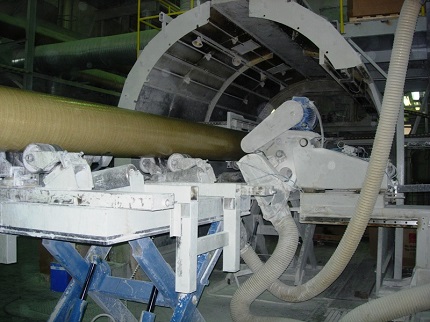
Manufacturer # 4 - Polyec
Polyek LLC makes various modifications of Fpipes fiberglass pipe products. The manufacturing technique (continuous oblique longitudinal-transverse winding) allows you to create three-layer pipes up to 130 cm in diameter.
Polymeric composite materials are involved in the creation of casing pipes, links of water-lifting columns, water supply pipelines and heating systems.
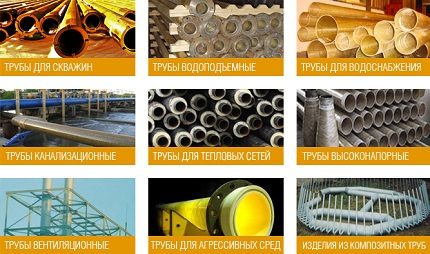
In addition to fiberglass pipes, the market offers a lot of products from other materials - steel, copper, polypropylene, plastic, polyethylene, etc. Which, due to its more affordable price, are actively used in various areas of everyday use - installation of heating, water supply, sewage, ventilation and more.
You can get acquainted with the characteristics of pipes from various materials in our following articles:
- Plastic pipes: types, specifications, installation features
- Polypropylene pipes and fittings: types of PP products for the assembly of pipelines and methods of connection
- Plastic ventilation pipes for hoods: types, their characteristics, application
- Copper pipes and fittings: types, marking, features of the arrangement of a copper pipeline
- Steel pipes: types, assortment, overview of technical characteristics and mounting nuances
Conclusions and useful video on the topic
Manufacturing technology and the feasibility of using fiberglass pipes:
Comparison of continuous and batch winding techniques:
In private housing, fiberglass pipes are used quite rarely. The main reason is the high cost compared to plastic counterparts. However, in the industrial sphere, the quality of the composite was appreciated, and worn-out metal lines to fiberglass are massively replaced.
Do you have any questions after reading our article? Ask them in the comment block - our experts will try to give an exhaustive answer.
Or maybe you want to supplement the material presented with relevant data or examples from personal experience? Please write your opinion under this article.

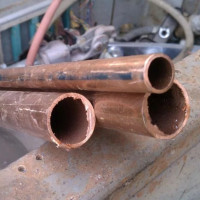 Copper pipes for heating: types, specifics of marking + application features
Copper pipes for heating: types, specifics of marking + application features 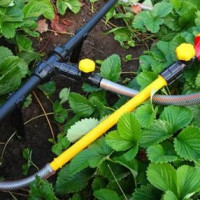 Pipes for irrigation in the country: a comparative overview of various types of pipes
Pipes for irrigation in the country: a comparative overview of various types of pipes 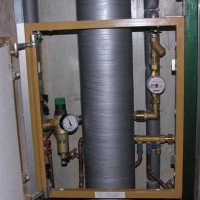 How to hide pipes in a bathroom: an overview of the best ways to mask a pipe
How to hide pipes in a bathroom: an overview of the best ways to mask a pipe 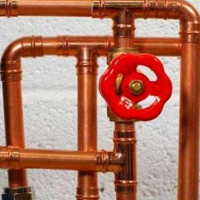 Water copper pipes: assortment marking, scope, advantages
Water copper pipes: assortment marking, scope, advantages 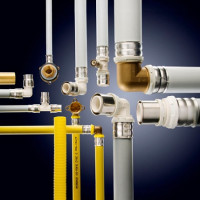 Plastic pipes: types, specifications, installation features
Plastic pipes: types, specifications, installation features 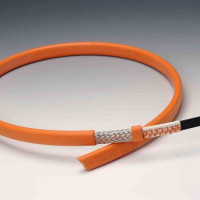 Heating cable for sewer pipes: types, how to choose and correctly carry out installation
Heating cable for sewer pipes: types, how to choose and correctly carry out installation  How much does it cost to connect gas to a private house: the price of organizing gas supply
How much does it cost to connect gas to a private house: the price of organizing gas supply  The best washing machines with dryer: model rating and customer tips
The best washing machines with dryer: model rating and customer tips  What is the color temperature of light and the nuances of choosing the temperature of the lamps to suit your needs
What is the color temperature of light and the nuances of choosing the temperature of the lamps to suit your needs  Replacement of a geyser in an apartment: replacement paperwork + basic norms and requirements
Replacement of a geyser in an apartment: replacement paperwork + basic norms and requirements
At one time, I did not choose the right fiberglass pipes for water supply and problems, of course they brought me a lot. They complained about the particles for some reason in the water, but they flowed constantly.